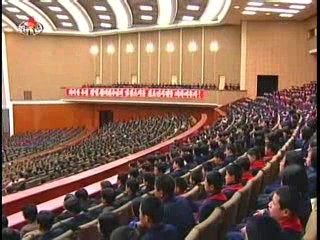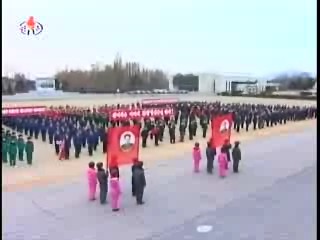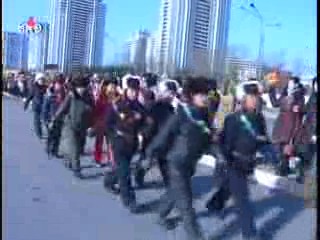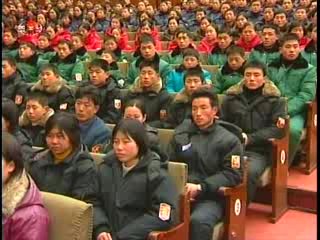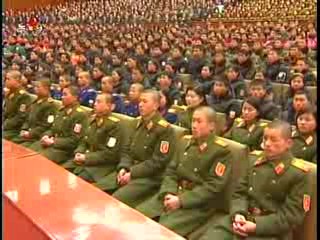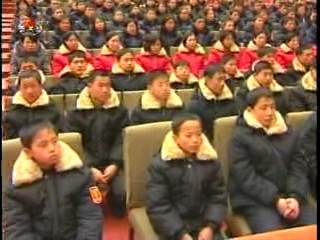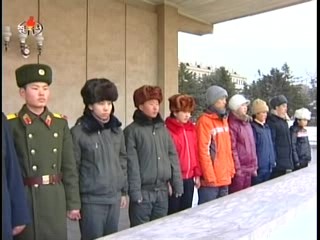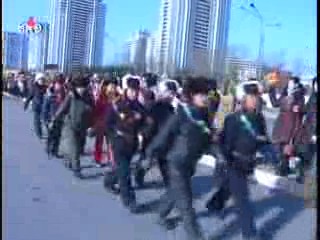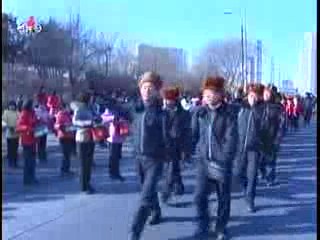Truckin' with the Kim Il-sung Youth League
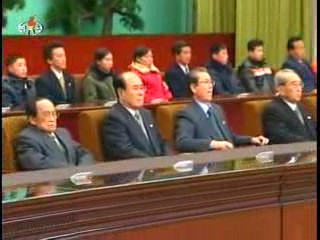
Front row from L to R: Secretary of Workers' Orgs Kim Jung-rin, SPA President Kim Yong-nam, International Secretary Choe Thae-bok and Secretary of Propaganda (Publicity) Kim Ki-nam preside over the KISYL meeting (Photo: KCTV)
Late last week, selected members of the Kim Il-sung Youth League embarked on a national study tour commemorating Kim Il-sung’s long, strange trip from Pyongyang to Jilin in 1925. Making a long story (literally, it’s a multi-volume epic) short, the late Suryong left behind his widowed mother and orphaned siblings in Pyongyang, attended the Yuwen Middle School in Jilin and subsequently expelled and arrested. The study tour undertaken by students and KISYL members traced the (ca.) 250 mile trip Kim Il-sung made from Pyongyang to the DPRK-China border:
The historic journey led to heralding the dawn of national liberation from the Japanese imperialists’ colonial rule and providing the origin of the revolutionary cause of Juche.
More than half of the journey was little different from pathless track.
In particular, the route from Kanggye to Huchang (then) was exposed to wild beasts even in the daytime.
However, the President continued the journey through primitive forests with a firm determination to avenge his father and the Korean people upon the Japanese imperialists for their occupation of the country.
He arrived at Phophyong ferry on February 3, Juche 14 (1925), thirteen days after he left his native place, Mangyongdae. He took a view of his fatherland and then of a foreign land across the river with bitter grief and sorrow.
Then he moved toward the foreign land, singing the “Song of the River Amnok” with a grim resolve not to return home until Korea became independent.
In 1975, Kim Jong-il initiated a study tour to retrace the late Suryong’s journey, which the current study tour also commemorates. The current study tour began last Thursday with a national meeting at the People’s Palace of Culture. Representing the North Korean leadership and presiding over the meeting was a motley quartet of gray eminences: SPA President Kim Yong-nam; KWP Secretary of Propaganda Kim Ki-nam; KWP International Secretary Choe Thae-bok; KWP Secretary of Workers’ Organizations Kim Jung-rin (who has a lot of staying power for a chainsmoking octogenarian). On the dais, but not mentioned in the KCNA report, was National Defense Commission Councilor Pak Myong-chol (standing in for Jang Song-thaek who was gallivanting around South Hamgyong with General-Secretary Kim).
First Secretary of the KISYL Ri Yong-chol was the keynote speaker who read off the meeting’s raison d’etre:
Kim Jong Il saw to it that the study tour of the course is organized as a traditional work of the youth league and statues of the President in his teens are built at significant places, thus making sure that the 1,000-ri journey for revolution made by the President is glorified for all ages, he said, adding:
Immensely bright is the road ahead of the new generation who are marching forward holding high the red flag of the revolution associated with the whole life of Kim Il Sung. All the school youth and children should rally close around the headquarters of the revolution headed by Kim Jong Il in single mind and creditably fulfill their honorable missions and duties as the successors to the revolutionary cause of Juche.
On Friday, the study tour’s participants convened at the Mangyongdae Revolutionary School for genuflections at a KIS statue and rally. The participants marched through Mangyongdae. In true KWP Workers’ Orgs. fashion, red flags were hoisted and sound trucks provided a revolutionary soundtrack. The KISYL members and students marched down Kwangbok Street though the Pothonggang District, encouraged by locals mobilized to cheer on the study tour participants.
Study tours on the “road to liberation” and “the road of the People’s Revolution” occur regularly in the DPRK. In East Pyongyang, there is a hostel for North Korean citizens who have made the requisite Pyongyang pilgrimage to the Revolutionary Headquarters. This is an anniversary celebration with the chronological symmetry favored by KWP propaganda officials. Last Sunday (17 January) also saw the 64th anniversary of the inception of what is now called the Kim Il-sung Youth League. The current study tour also traffics in direct and opaque references to a potential hereditary succession by Kim Jong-un (-eun).
One might look at Ri Yong-chol’s statement at the Thursday kick-off event: “Immensely bright is the road ahead of the new generation who marching forward. . .” Kim Jong-il “has wisely led the work to bring up the school youth and children to be reliable revolutionary vanguard fighters who would steadily carry forward the march started on Mt. Paektu.” At the Friday start of the study tour, “school youth and children who display the spirit of devotedly defending the leader while steadily inheriting the lineage of Mangyongdae, the lineage of Mt. Paektu.” Kim Jong-un (-eun) and Kim Jong-chol are certainly part of the Mangyongdae and Mt. Paektu lineage.
More interesting, however, are the references to Kim Jong-il’s initiation of the liberation study tours in 1975, and Kim Il-sung’s revolutionary activities in his youth. 1975 was the year after General-Secretary Kim had been put forward as successor at a plenum session of the KWP Central Committee. The focus of the study tours are the activities of a 14-year old Kim Il-sung. One of the bigger question marks circumscribing the Morningstar General’s succession concerns the nomination of a person in their late 20’s to a job bequeathed to men in their mid-30’s. Kim Il-sung was 34 in 1945, and Kim Jong-il was 33 (although technically he was 32). By emphasizing Kim Il-sung’s formative accomplishments as a teenager, the Central Party can in part remove the age issue as an impediment in the succession campaign.
Even if there were no succession implications behind the commencement of the liberation study tour, Pyongyang watchers were at least afforded the opportunity to see the stone-faced countenances of fourth- and fifth-generation North Korean leaders.
You can view a large collection of KCTV screen capture photos from the national meeting and kickoff rally/parade here.
Selected screen captures off KCTV from the national meeting in advance of the 2010 Liberation Study Tour, 21 January 2010:
Selected screen captures off KCTV of the kick-off rally and parade of the 2010 Liberation Study Tour:
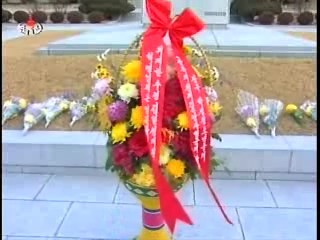
A KWP floral basket put at the foot of the KIS statue on the campus of Mangyongdae Revolutionary School by KISYL on 22 January (Photo: KCTV)
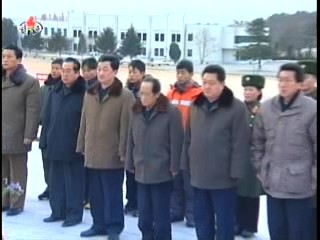
Kim Jung-rin and Ri Yong-chol (front row 4th and 5th from L) genuflecting at the KIS statue at Mangyongdae Revolutionary School (Photo: KCTV)
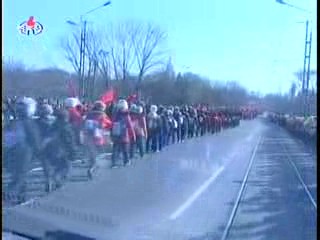
If you strain your eyes to the center-left of this shot, you can see the tip of the Ryugyong Hotel (Photo: KCTV)
